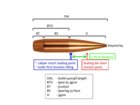With a new powder, the first thing that I do is to do a sort of ladder/pressure test at 100 yards. I say sort of, because I am not just looking at elevation. I am looking for how shots cluster. I drop down to a low charge that literature tells me is not too low to be safe, and load one shot per charge at an interval that is appropriate for the case volume, on cases like the .222 up through the .308 .3 gr. I shoot all of the shots on a single target, over flags, on a morning when the wind is not difficult, and continue until bolt lift tells me that I should stop. One needs to pay close attention to do this. So many time I have seen fellows who after a clear indication that a load was too hot, ignored the obvious and chambered another one. Do not do that. After I get signs of excessive pressure, I note the temperature and humidity, and the charge just below it as maximum. Obviously, a max charge arrived at in cold weather will require retesting when the temperature is significantly warmer. At the end of the test I will usually have a target with some clusters of bullet holes made by consecutive charge weights. At that point I will load a three shot test using the middle load of the most promising cluster. I do this with the bullet seated into the rifling by an amount that I have found good results with before, so that my maximum pressure will be worst case, since jumping with that load would result in lower pressure. After I have a charge weight, I experiment with seating depth. Generally, if I can, I do all of this loading at the range. My friends who do not, generally have to invest several trips to the range into getting to a point that I can get to in less than two hours.











